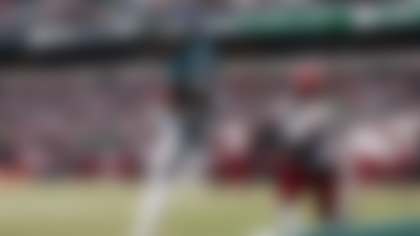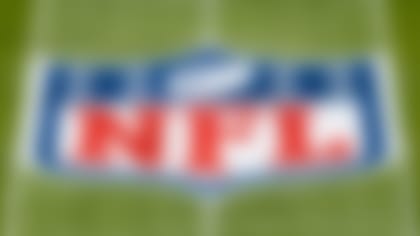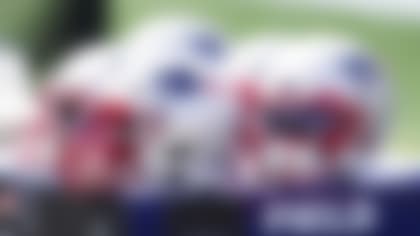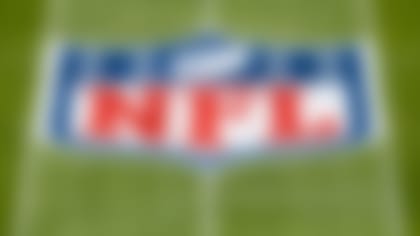The NFL hosted a health and safety-focused media briefing on October 18, 2022, at the 2022 Fall League Meeting in New York, New York.
Speakers:
- Jeff Miller, NFL Executive Vice President Overseeing Player Health & Safety
- Dr. Allen Sills, NFL Chief Medical Officer
Miller: We presented to the owners an update on several health and safety initiatives. Around this time of year, we share with them preseason injury data, specifically against any priorities we have, which I'll get into in a moment. But obviously the primary conversation piece with the owners today was around the changes to the concussion protocol and what's happened over the past couple weeks. I know you're all aware – we spoke with many of you collectively or individually about this, but we have Dr. Sills here to take you through that again and share a few other things we discussed with the owners.
Sills: Thanks, Jeff. Good afternoon, everyone. So just a couple of points around the concussion protocol change, just to highlight what was done and how it was done. With the new change in the protocol, we basically have two video signs of concussion that are diagnostic. One is a so-called impact seizure fencing posture, which I think you're all familiar with. And the second is now ataxia. Ataxia is a neurologic term is something we all learned in medical school – it refers to loss of balance or coordination that starts or comes from the brain, obviously. And so those are our two diagnostic signs of concussion from video only. Anything else that we diagnose for concussion is going to not be based on video, it's going to be based on the reported symptoms, observed signs when players are being examined. And I probably point out that still, those videos diagnosed cases represent a small minority of overall concussions. Meaning most concussions don't have one of those obvious video signs. Our instructions and our teaching and in our gameday personnel around those video signs is something that is clear and obvious... But I'm going to just emphasize again, that still the cornerstone of our diagnosis remains interviewing a patient. Taking a history, getting symptoms, conducting a neurologic test. And that's the basics of concussion care for any of us, whether it's on the sideline or in the hospital, in the emergency room, or wherever we may be. So, we've talked a lot about that change.
But one of the things I wanted to highlight – and I mentioned this previously – is we still need to find better diagnostic tools for concussions. Right now, we are still so heavily reliant on self-reported symptoms and imprecise tests. So, I just want to highlight that we think that we, the NFL, think we have a role to play in advancing that in advancing concussion diagnosis through these more objective markers. The concussion diagnosis is hard. And I've said this, it's imprecise but we hope the better diagnostic tools will help us make a more definitive clinical decision. Just as it's happened in other aspects of medicine. So, through our Scientific Advisory Board, we're funding that research. We've already spent several million dollars on things like blood biomarkers and eye tracking, we'll continue to do that. And some of our colleagues at the Players Association will join us in really advancing those trials and trying to get some of the technologies, frankly, on the sidelines sooner rather than later so that we can use them to help with this diagnosis. I'll stop and Jeff you can talk about soft-tissue injuries.
Miller: So going back, again, and just as a frame for everybody. We talked about this, I think after the March owners meeting, the densest period of time for injuries for NFL players is right at the beginning of the season, right when you get to training camp those first several days. If you recall, we talked about ramp-up periods and other acclimation that we wanted to engage in this year or mandate to build on some insights that we had to try to decrease those number of injuries. So, the first four days of the preseason, followed by an off day, followed by the next four days when the pads come on, or the period of time more so than any other time during the course of the season that we see player injuries. This goes for lower extremity injuries, this goes for concussion, this goes for everything – you see spikes, and I think we've shown you some of that data before.
So the effort that we engaged with our engineers and other experts about was how can we decrease the number of injuries and those that period of time. The challenge was so significant in our minds, that we were seeing on average every club for two to three players who suffered an injury, a hamstring strain, groin or something like that, in the first 10 days of training camp, that every club had somebody – two or three players – who suffered those injuries right at the beginning that carry through going into the regular season. It's that substantial. And so this year, the owners passed an increased activation or ramp-up period, with the limitations on the number of minutes or players to be on fields that were lesser than they had been previously. When the pads came on, we did another ramp up period for a series of days. Additionally, we mandated that every player engaged in any team activity had to wear data sensors for the first time.
Anyway, cutting to the chase for that period of time, on lower extremity injuries, we saw a decrease by 26% of lower extremity injuries for that period of time during this first week and a half or so training camp. Overall injury during the course of the preseason was down 14%. And those lower extremity injuries were down 16%. So again, 26% decrease, year over year in that time period, we were trying to affect that with the ramp up period. That gives us a lot of a lot of hope, that some of these things that we're doing, we can continue to do next year. The sensor data that we're pulling back again, so we can share with clubs on one-on-one basis. How are you comparing to all other 31? How much are your players on field? How much are they ramping up? How many accelerations do they have, how much duration, how much time on the field, how far were they traveling during that period of time? And one interesting note was that we saw that despite the fact that those timelines were mandated, that players were still traveling the same amount of time, same amount of distance they were in previous seasons, but their injuries came down 26%. We're having some sort of insight against a longer-term injury area, which is of great importance to us. Obviously, we have to see how this plays forward during the course of the regular season. The goal there is obviously the decrease all injuries and see if the savings we got in the preseason will be replicated in the regular season. But hopefully we'll be off to a good start. The second intervention was around the Guardian Cap. Concussions, also advanced period of time for injury, receiving certain position groups that we've all talked to you about. Allen, do you want to come up and review our findings there?
Sills: I would say just in summary that the Guardian Cap was an extremely successful program with a lot of promise. The numbers would tell us that the position groups who are required to wear the Guardian Cap during preseason practice had a 52% reduction in concussions, versus the three-year average of those. At the same time, those position groups that weren't wearing the cap, their concussion incident stayed the same. But that tells us that it wasn't just the teams were practicing, let's say less aggressively or with less speed or things of that nature. But literally, those positions who wore the cap seem to have significant protection. The concussion rate for players who wore the Guardian Cap was not increased after the mandatory period ended. So that was another question that people had raised, would that cap change their style of play? We did not see that. And we actually saw about 200 players continue to wear the Guardian Cap after the end of the mandatory period in training camp, which we think was very helpful. We still know there are a number of players wearing and even today, and we hope that that number will continue to increase.
Now the number of concussions by players in preseason wearing the cap is not the only measure of success for the Guardian Cap. One of the things that we emphasized is we think it protects against an accumulation of hits. So, we're tracking very carefully, how did those position groups that were the Cap in preseason, what's their concussion rate look like through the rest of the season? We think that's going to be an important observation. So there is clearly more work to be done, but as I said, an extremely promising and really successful start. And obviously, our group and together with Roy, Rich and the football group will discuss where we go from here as far as future years, in 2023 and beyond. We are working, by the way, on some of the issues that we identified with the Cap with bit with security of the Cap and things like that. But we did not see any increase in neck injuries, for example, the players were wearing Guardian Cap, or other injuries associated with that. So again, more work to be done. But a very successful for the launch of that. Okay, we'll take some questions at this point.
QUESTION: A lot of questions about those biomarkers or how the NFL needs to get more involved in figuring that out, funding more projects. You contextualized the how there is the worldwide global effort toward actually finding that objective way. The NFL, are you guys going to break through or contributing to finding that?
Sills: Well, this is something that people have been working on for a number of years, obviously. And again, it's not just blood biomarkers, or salivary biomarkers, there's eye-tracking technology, pupillometry. I could go on, and there are a lot of these. A lot of people are doing really good work. I think our role is to continue to get behind them in the short term with funding but then as I said, hopefully we can take some of those technologies and bring them into our ecosystem. In participating in clinical evaluation, and how useful those are. There are already people, spotters on-site, right, but then you also have a on a sideline tool to help me know whether someone is concussed or not. That's the Holy Grail, if you will, of concussion diagnosis.
But then you also have to determine return to play and recovery. Again, we have a multi-layered process as you know right now that includes neurologic exam, multiple consultants, and neuropsychological testing. But you'd love to see some of these tools play a role there as well. We don't ever introduce anything into our protocol that's not extremely thoroughly vetted and scientifically proven to be a benefit. But our thought is that we certainly will continue to support the research financially. But we would love to see clinical trials, with players who are known to be concussed already, that are focused and ready to evaluate the role of these technologies. And literally to find out which of them seems most applicable for this particular situation. And by the way that may be more than one tool, you know, it may not just be a single tool.
Miller: We're not starting from zero. Over the course of the last seven, eight years, the league has invested millions of dollars in different research grants with different partners to get exactly this challenge. You may remember we had a partnership with the Canadian Football League around an eye-movement tracker called the King-Devick test, to see whether or not that was able to diagnose concussions as accurately as the subjective or expert measures that we have on the side. Didn't prove out to be great, but it was worthy of the investment. We've done similar sort of partnerships with other institutions, universities, others – decided to sort of push the research forward on objective measures of concussion. The hope now, and I think Allen reflects this, is that we're closer than we ever were. I think we were in a good place to regroup. Wise to invest in the research when we did, and now there's a hope that we're going to be making a lot more grants much faster and be able to apply something on field, at some point relatively soon.
QUESTION: A follow-up, you say "relatively soon." Not to put a time point on it, but are you able to put a time point on it.
Sills: Sooner than when we started investing seven or eight years ago.
QUESTION: You have two weeks-worth of data from the new concussion protocols, updates. How has it gone, and could you give us a little more clarification of what happened in the situation with Teddy Bridgewater, in the Dolphins game?
Sills: Sure. So as far as data, you know, we really don't look at as much week-to-week because there could be so much fluctuation across injury. We try to look at bigger blocks of time. But obviously one of the first things that you want to do when you make a midseason protocol change is try to ensure consistency. So we've spent the two weeks in trying to educate all of the people that participate in that system which is spotters, our unaffiliated neurotrauma consultants, visiting team medical liaisons, our team athletic trainers, our team physicians. You know, that's over one thousand people that we're trying to bring to that level of consistency and understanding. So that's what we really spend a lot of time in doing. And we obviously, are the major medical progresses, we keep getting better. As you make a change, you learn, and you see how it affects things and how you can do better. Your question around the Teddy Bridgewater situation. I think, again, when you make a protocol change, you're asking people to apply a standard. I've said to you that we want that standard to be what I call clear and obvious and, and that's why we've used video examples of that [to train medical staff]. There's always going to be some element of medical judgment. But I would just emphasize, that's not one person. You know, I think one of the things that I might see that is inaccurate, is that one person is making that decision, but that's not ever happening. Our systems are built around teams of professionals who are making these decisions. For example, up in the spotters booth, there are five people. There are two spotters, an unaffiliated neurotrauma consultant and two video technologists. They're all working together to produce the best view to reach that consensus and communicate that to the sideline. Last thing I would say is for people being more cautious and conservative now – that's a natural human reaction. And I think that we've consistently said we want to be conservative with our concussion protocol. As I've shared with you all, we examine three or four players who aren't concussed for everyone that are diagnosed, and we'll continue to be conservative. But I think it's a natural reaction to take these changes, and a lot of them are really conservative.
QUESTION: Dr. Sills, about Bridgewater and about just sort of the change in protocol, in general. So specifically, the spotter upstairs – What is that spotter upstairs? What is his or her qualifications? And then I'll follow up.
Sills: So there are two spotters upstairs, and they are people who are basically athletic trainers who have a background in football. Many – and I should check to get the statistic – many, but not all of them have worked with us for over a decade in doing this. They are upstairs, again with two technicians who support them with the video we have. And then there is an unaffiliated neurotrauma consultant upstairs. That man or woman is typically a neurosurgeon, or neurologist or emergency physician. Someone with expertise in treating brain and spinal injuries. So their job in the booth is to constantly watch the field, as well as watching the video. They typically, on most games, have between 25 and 35 different camera video angles available to them. They've got a lot more angles than any of us do. And they're looking specifically for are players who suffered a blow to the head or neck area and who may be displaying injury behavior that they think needs an evaluation. They do that in a collaborative fashion, in where someone spots something, they'll discuss it with each other, and then they have the ability to communicate to the field. They can communicate with either sideline, obviously, with the medical staff that are connected by radio. They also can communicate with the referee and the white hat. And so that's our medical timeout that you may be familiar with, where if they see a player still on the field that they think is injured, they'll call the medical timeout, which means stopping the game to get the player off the field.
QUESTION: Specifically, about this Bridgewater case. What I thought was kind of interesting is that all of the views that we saw, and the next day will Channel 7 in Miami showed 65 or 70 seconds of Bridgewater, after he got up, there was no apparent sign of ataxia. And I think that's the question. You know, that was, and again, I'm not trying to say, 'Oh, my God, you know, this guy absolutely should have played.' I don't know whether he should have played or not. But I just never saw and never heard what the obvious sign of ataxia that he shown by Bridgewater that eliminated him from the game. I'm wondering if you can expand on that?
Sills: Well, as I said, anytime that we have – first of all, all of our video diagnoses of concussion get reviewed, and we look at them collectively, again as part of our quality improvement process. So what I can share with you in that particular case is that the team in the booth, not one individual, but the team in the booth consisting of the two spotters and that unaffiliated doctor, felt that they saw a stumble on one of the video views that they had provided, as well as a player I grasping his head, or something to that effect. And so, in their mind, with this new standard that they had literally been given the day before, they felt that that reached the standard of having to fall down and identification to the sideline. Obviously, the sidelines did not seem to have access to the same videos that they did. The best answer I can give you to your question, I think, as I said, this is a process that will be an evolution and this story was mentioning about different people looking at different videos. You know, medical professionals sometimes look at the same evidence and reach different conclusions.
We see that in the hospital every day. All we ask them to do is to apply their best medical judgment and to do it as a team. And I think that's what's important is not one individual. It's a team of people working together.
QUESTION: Two questions. One piece of information, that injury statistic that in the first 10 days down 26% - is that soft tissue injuries?
Sills: Lower extremity and soft tissue.
QUESTION: And overall?
Sills: 14% is injuries overall. And that is for the course of the preseason. 16% is for the lower-extremity injuries.
QUESTION: And then my other question is related to the concussion protocol. In the aftermath of the protocol changes, has there been any conversation about the return-to-play congressional protocol? There's been some chatter or buzz about it – but will teams maybe be more reluctant to bring players back as quickly as they had? I'm just wondering what you're hearing about that, if there's been any review or discussion about your view of the returning-to-play protocol?
Sills: Well, once it gets defined, just like the gameday protocol, our return-to-play protocol is something that we're always evaluating. We look at not only the length of time, but how much time people spend in each step. And all of that. Again, making this degree to highlight all of their steps – you know, a player has to have no symptoms. They have to go through five graded steps of exertion to look for symptoms. They have to be seen by the team neuropsychologist, and then testing done compared to their baseline. They have to be reviewed by an independent neuro-specialists who reviews all the evidence, and then they have to be seen by the team doctor. So again, many different steps and many different people are involved. Our median time right now for return is about nine days, I believe. That's been fairly consistent over the last year or two. I think again, teams always try to be cautious, they always try to be conservative. But back to the discussion we were having a minute ago about biomarkers – still today our return-to-play protocol relies upon heavily elf-reported symptoms and objective neurologic findings. We embrace that protocol and the best evidence is out there, but then all of us recognize that we would love to have some more of these objective markers that would continue to help patients. I think we've always been conservative; we will continue to be conservative and once again to have those medical decisions rely on a full panel of experts. As you've seen recently in some of the high-profile cases, sometimes the club will leave and reach outside and get other independent experts to try to ensure that there's a level of comfort about a player returning.
QUESTION: What are the plans for potential expansion in the use of the Guardian Caps?
Miller: That's a conversation we'll have, both with our experts as well as with our players. I think that there's a lot of evidence to show that there are benefits. We're going to do further laboratory testing, we want to know against collisions that they that they've experienced, difficult on the speed or frequency, to see what the impact of the Guardian Cap on those positions. I'd like to think that we'll take a look at expanding it beyond a period of time. Obviously, there's a benefit for that period of time, whether it be a greater benefit for a longer period. Then I think there's a technological aspect. We're working with the company now, around our experience great feedback, because there's feedback from trainers and players about fit or sizing or some of the other elements that he discussed. So hopefully, we're going to have a better version of that. And we've begun conversations with others including the helmet manufacturers around what to practice. That could possibly somebody will see in the future, if you're able to create a product that has the ability to absorb more of the force, provide a lot of benefits regarding the Cap, let's explore that. I don't know if that's an extra thing. But somewhere down the road. So other positions maybe, longer period of time, testing new technologies over that period of time, always looking ahead. But again, we're doing this in partnership with our medical guys.
QUESTION: I realized the concussion protocols are jointly negotiated with the NFLPA. The protocol state, you mentioned that it's a team effort, no question there's a lot of people involved. But the protocol still state that the team physician ultimately has final responsibility for diagnosing concussion. He's often not a neurologist, usually an orthopedist. Why is that the best person to be in charge of that decision, as opposed to one of the UNCs?
Sills: A couple things about that. First of all, the team physician who is in charge of concussion care is never an orthopedist. It's always going to be either a primary care sports medicine or internal medicine-trained individual, or physical medicine who has experienced treating the brain. So it is the physician – it is not the up necessarily the overall head team physician, it is the physician that the team has designated to be in charge of concussion care. Secondly, anytime in medicine that you deal with a clinical decision making, ultimately you have to have an ultimate authority decision maker. So for example, if we have a cardiac arrest, we have what's called a code leader. Someone has to direct who's going to do what and who is going to give medications and things like that, so we have to assign that role to someone. I think the reason that the team physician is identified is because they are able to take the totality of the input and they know the athlete and their history and can act upon that in the most holistic way possible. I think there are a couple of important points about that I think the question is getting towards. One is, they're willing to do that in a collaborative fashion. And I've said this before, that it almost never happens. That I'm the team doc, and Jeff is the UNC, and we disagree. We see that happens maybe once an entire season, the several hundred concussion evaluations we do. But if that happens, and Jeff says, "I'm a UNC, and I think there was a concussion." Then I say, "I'm the team doctor, and I don't," and we just can't agree to that. We've instructed our physicians to go with a more conservative recommendation and keep the clutter out. And that's what they're always going to do. You're never going to see a situation where the team doctors is going to overrule someone. The second point I would make is, I think the term "team doctor" sometimes implies that the doctor is loyal to the team, but it is not. I can just tell you as a physician, which I am, my loyalty is to the patient. Period. And my supervision, my authority is ultimately from my state medical board license to the standard of the hospital and the clinical setting I practice in, and my peers. That's who I'm concerned about. I can tell you from equivocally, that our team physicians are not influenced by coaches or general managers or owners or anyone else. They're practicing medicine to a standard of what they believe to be the absolute best for the patient. Sometimes other doctors might disagree with that judgment. That happens all the time in medicine, where I think it's pneumonia and he doesn't or things like that – but we should not question their integrity or their loyalty or their commitment to their patients. They don't care who the player is. They don't care what position. They really don't even care about the score. And I know that may sound hard or or difficult to fans, but that's the reality of who we are as physicians. And I'll say one more personal word on that. I'm a surgeon and when I'm in surgery, when I go to the operating room and I'm operating on somebody, I can't be consumed by the environment or the things in them. I have a job to focus on. I have a set of protocols; I have a set of standards. That's what I have to do. Doesn't mean I'm not compassionate or engaged, but what I'm not is influenced by what I would call the externals. I think it's important to recognize that yes, the team doctor has that, but it is a collaborative effort. They're not going to overrule someone. Their loyalty is very much to what they think it's best for that patient at the moment.
QUESTION: Kind of staying right there. I see what you're saying about, you know, usually there's not a disagreement when you're talking about the evaluation. But now that you're having the ataxia and the stumble, and kind of like what Peter was saying – when we all watched that video, I don't think we saw a stumble. I'm not saying he shouldn't play that; I don't know better than anybody who reviewed the tape. But that's a bit more subjective. Is it still when you're talking about that part of it? Let's lean more to the conservative. Is that the guiding principle?
Sills: Absolutely. I think we've been very clear, we want to be conservative. And if we're going to make a mistake, we're going to make a mistake on the side of being conservative. Meaning we would rather hold someone out who's not concussed and not let them play, than to let someone play who is. That is our philosophy. As a leader. And I believe that's helped by this protocol. Again, Mike, sometimes there is going to be differences in judgments among healthcare professionals. But that's how we learn to get better is to discuss those and work together in classifying these systems.
# # #
To read the key takeaways from the 2022 preseason injury data, click here.












